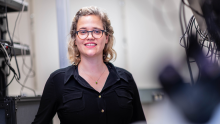University of British Columbia researchers have invented a safe, efficient technology to wirelessly charge electric vehicles using “remote magnetic gears” – and successfully tested it on campus service vehicles.
“Wireless charging has been a much sought-after technical solution for everything from cell phones to electric cars,” says UBC Physics Prof. Lorne Whitehead. “A significant concern for charging cars wirelessly has been the high power and high frequency electromagnetic fields and their unknown, potential health effects on humans.”
Prof. Whitehead and his team invented a completely different method operating at a frequency 100 times lower and with negligible exposed electric fields. Their solution uses “remote magnetic gears” – a rotating base magnet driven by electricity from the grid, and a second located within the car – to eliminate the use of radio waves. The base gear remotely spins the in-car gear, which in turns generates power to charge the battery.
Four wireless charging stations have been installed at UBC’s Building Operations parking lot and service vehicles retrofitted with the new technology. Tests show the system is more than 90 per cent efficient compared to a cable charge. A full charge takes four hours and enables the vehicle to run throughout an eight-hour shift.
“One of the major challenges of electric vehicles is the need to connect cords and sockets in often cramped conditions and in bad weather,” says David Woodson, Managing Director of UBC Building Operations. “Since we began testing the system, the feedback from drivers has been overwhelmingly positive – all they have to do is park the car and the charging begins automatically.”
The team originally conceived the magnetically driven charging system for medical devices such as an implanted pacemaker. The larger system, supported by the NSERC Innovation Grant, was tested at UBC as part of the Campus as a Living Laboratory initiative and provides valuable data for further research and development. A patent for the technology has been filed through the University Industry Liaison Office.
For more information and to watch videos of the wireless charging system at work, visit www.ubcwirelesscharging.ca. B-roll can be downloaded from http://bit.ly/Xb3E8I.
Musqueam First Nation land acknowledegement
We honour xwməθkwəy̓ əm (Musqueam) on whose ancestral, unceded territory UBC Vancouver is situated. UBC Science is committed to building meaningful relationships with Indigenous peoples so we can advance Reconciliation and ensure traditional ways of knowing enrich our teaching and research.
Learn more: Musqueam First Nation
Faculty of Science
Office of the Dean, Earth Sciences Building2178–2207 Main Mall
Vancouver, BC Canada
V6T 1Z4


